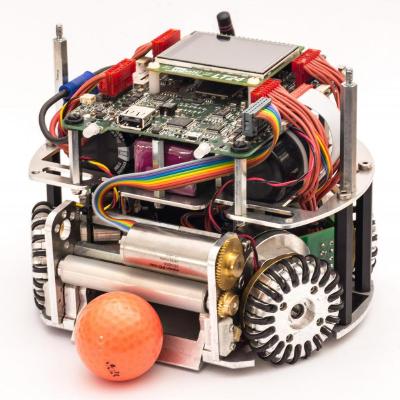Two technical challenges will be held at RoboCup 2013.
These challenges are designed to encourage SSL teams to develop technical contributions and to test ideas that can evolve the league towards the RoboCup goal of 2050. In order to motivate more teams to participate in the challenges, there is no qualification constraint, and the Committes encourages all the participating teams to compete in the challenges.
Until May 31st, teams interested in participating in any of the challenges need to announce their interest to the Organizing Committee . This is necessary for the preparation of the schedules. Please state in which challenges your team is planning to participate.
Shooting Challenge
This challenge will test the team’s shooting accuracy and ability to score a goal against four slowly moving defenders and one goal keeper. The task is to score from seven fixed positions in the field of play as depicted in the image below. The aim of this challenge is to score as many goals as possible.
- Each team is allowed to have a single robot on the field of play during the challenge.
- The exact ball positions might be subject of change.
- The balls are placed one by one by the referee.
- For each ball position a “direct freekick” command is issued by the referee box. After the shot has been completed a “stop” signal will be sent and the next ball is placed.
- During ball placement a “halt” signal might be sent due to vision interference. Robots need to adhere to the “halt” signal and stop moving.
- The standard rules for the execution of a direct freekick apply, e.g., no double touch and lack of progress. During stop mode the robot needs to keep distance.
- Four defenders will move slowly along the outside of the defense area. The goal keeper will move slowly between the goal posts.
- Own goals by the slowly moving defenders or goalie are not counted.
- It is not allowed to interfere with the defenders or goal keeper. If the attacker contacts any of the defenders or the goal keeper, the number of goals is reduced by one.
Each team will have a single turn. Each ball position will be used twice. Therefore, a maximum of 14 goals can be achieved.
Each team is allowed to cancel the turn and restart the challenge once. The turn may be cancelled only before the last shot has been taken.
Navigation Challenge
Three robots have to navigate through a dozen of static obstacles from the left side of the field to the right side of the field, while crossing the center point of the field. The obstacles are randomly distributed in the center of the field. The goal is to reach the target positions as fast as possible.
- Obstacles are randomly scattered in a virtual circle around the center of the field of play. It will be ensured that at least one path with the width of at least two robot diameters will exist through the obstacles to the center of the field from each side of the field. Examples of possible routes are depicted in the image below as lines with arrows. It does not matter which particular robot fills each target position.
- Teams will not be allowed to test with the final obstacle configuration before the technical challenge.
- Each team needs to have three robots navigating through the field, placed in each corner (corner kick position) and the penalty point as shown in the image below. Blue points are starting positions and yellow points are targets.
- All robots have to reach the center of field (indicated in violet in the image below) before reaching their target, such that a successful pass is recorded. If a robot moves to the target position without reaching the center of the field, a successful pass is not counted until the robot moves to the center of the field first and then moves back to its target position.
- Each collision with an obstacle will result in a time penalty of 5 seconds.
- Each collision with another robot will result in a time penalty of 7 seconds.
- Pushing or substantially dislocating an obstacle will result in a time penalty of 10 seconds.
- To begin the challenge a “force start” signal will be sent from the referee box and the clock is started.
- The clock will be stopped once the last robot as reached its final target and stopped moving. It is understood that the target position and center point might not be reached exactly due to vision noise. An error of 5cm is considered to be sufficient for this challenge.
Each team has two tries, and the best time is recorded as the final result.
Participating Teams
- ER-Force
- MRL
- Parsian
- RoboFEI
- Skuba
- Tigers Mannheim
- UBC Thunderbots
